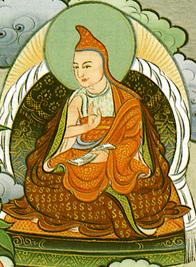Shedra: Difference between revisions
No edit summary |
No edit summary |
||
| Line 1: | Line 1: | ||
'''Shedra''' ([[wyl.]] ''bshad grva'') - the Tibetan word shedra literally means a ‘centre for teaching’. In traditional monastic centres, the shedra is the school where monks and nuns study the most important Buddhist scriptures, based on the explanations of their teacher, or [[khenpo]]. | [[Image:Khenpo Shenga thangka.JPG|frame|'''Khenpo Shenga''']]'''Shedra''' ([[wyl.]] ''bshad grva'') - the Tibetan word shedra literally means a ‘centre for teaching’. In traditional monastic centres, the shedra is the school where monks and nuns study the most important Buddhist scriptures, based on the explanations of their teacher, or [[khenpo]]. | ||
Amongst the first, and perhaps the most famous, of Tibetan shedras was the one at [[Dzogchen monastery]] called [[Shri Singha shedra]], founded in the nineteenth century by the great master [[Gyalsé Shenpen Thayé]]. His reincarnation, the great [[Khenpo Shenga]] (1871-1927), who taught at several shedras including [[Dzongsar]], wrote several volumes of brilliant commentaries, which helped to establish the standard curriculum in many shedras, particularly in the [[Nyingma]] and [[Sakya]] monasteries of eastern Tibet. | Amongst the first, and perhaps the most famous, of Tibetan shedras was the one at [[Dzogchen monastery]] called [[Shri Singha shedra]], founded in the nineteenth century by the great master [[Gyalsé Shenpen Thayé]]. His reincarnation, the great [[Khenpo Shenga]] (1871-1927), who taught at several shedras including [[Dzongsar]], wrote several volumes of brilliant commentaries, which helped to establish the standard curriculum in many shedras, particularly in the [[Nyingma]] and [[Sakya]] monasteries of eastern Tibet. | ||
[[Category:Key Terms]] | [[Category:Key Terms]] | ||
Revision as of 07:50, 9 September 2007

Shedra (wyl. bshad grva) - the Tibetan word shedra literally means a ‘centre for teaching’. In traditional monastic centres, the shedra is the school where monks and nuns study the most important Buddhist scriptures, based on the explanations of their teacher, or khenpo.
Amongst the first, and perhaps the most famous, of Tibetan shedras was the one at Dzogchen monastery called Shri Singha shedra, founded in the nineteenth century by the great master Gyalsé Shenpen Thayé. His reincarnation, the great Khenpo Shenga (1871-1927), who taught at several shedras including Dzongsar, wrote several volumes of brilliant commentaries, which helped to establish the standard curriculum in many shedras, particularly in the Nyingma and Sakya monasteries of eastern Tibet.